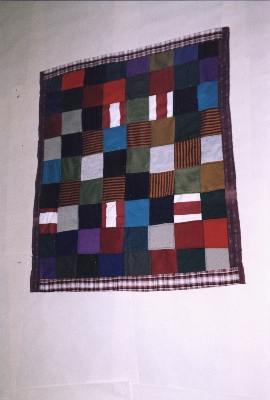Quilt No.724GPM - Griffith Pioneer Park Museum

1060 x 940mm
May Carter made this quilt in 1992 and, whilst it is well outside the date parameter, it is included in the register as May made about 200 quilts in her lifetime and this is one of the last she made. It is hoped many of the others will be registered over time. It was made at Griffith NSW and donated to the Pioneer Park Museum by the family after May's death.
"May's Waggas
May Carter was born May Turner in 1919 at Cambeligo (near Wellington), the third of a family of twelve children. Her grandfather, Harry Turner, had already taken up an early farm at Hanwood in 1912 and May's family returned to Griffith when she was 3 weeks old. The family lived first in a four roomed bag house they built where the Merrigal Street Nursing Home now stands. The outer walls were calsomined (powdered paint put on like white wash) and the inside walls were covered in pieces of newspaper and magazines applied with flour paste.
Peg Gamble [sister] recalled that they never had anything very flash - her mother knew a hundred ways to cook rabbit; handkerchiefs, teatowels and underwear were made out of flour bags (everyone's bloomers were the same size and flash if they had a bit of lace), and floor mats were woven out of rags. She recalls her mother crying because she yearned for a shop bought dress. It was tough but everyone was in the same boat. Those who had a steady job were the upper crust, most took work when and where they could get it.
In this context of necessity, both May's mother and grandmother made Wagga Rugs to keep their families warm in winter - as the family blankets. Cut up skirts, old jumpers -anything that had a bit of weight in it -were handsewn to a backing of unwashed opened out wheat bags. The filling was then covered with an old blanket or a top made of pretty scraps of cretonne and dressmaking remnants. They were 'mighty heavy' and were beaten on the clothesline rather than washed.
By the time May married in 1935, as Peg Gamble recalls, they were getting a bit too posh for Wagga rugs as blankets. Nevertheless May continued to make Waggas up until her death, mainly for camping trips and fishing, to save the good bedding. Her early Waggas described to me, now long since worn out, were made the same way as her mother and grandmother had made them. May's daughter Bev has vivid memories of Waggas from her childhood made of matted cardigans and other old clothes, fitted together and buttonholed onto an old grey army blanket base. One of these belonging to her brother was particularly memorable - featuring a full army greatcoat, with the buttons still on. It weighed a ton, as one might imagine, but was treasured by her brother. Other materials used in Waggas came from scraps left over from May's work as a dressmaker.
As time went on, fishing friends of May's husband, friends of her children, friends of friends and many others admired and coveted these Waggas and May began to make them in large numbers, right up until her death. She has even left Waggas for great grandchildren yet to be born to grandchildren not yet married.
Making Waggas became her hobby, and with it a passion for collecting material - haunting used clothing stalls at fetes and second hand shops. When bags of offcuts of knit fabrics from making came her way in recent years she used those. Her technique refined to a lightweight machine-made multi-coloured patchwork rug without filling. She enjoyed playing with colours to get pleasing combinations of colours - bright rugs, earthy rugs, plum coloured rugs.
Six months before she died she finally got around to making a Wagga for herself in her favourite green. Fittingly she was buried in it.
The form and function of May's Waggas may have changed over time, but hers is an interesting story of an old craft of necessity continued on to the present."
[Robyn Oliver, Griffith Pioneer Park Museum 27.1.1993]
Related Quilts:
2109 x 1702mm
1570 x 152Omm
2211 x 1752mm
1200 x 700mm
1800 x 1630mm
2180 x 1710mm






